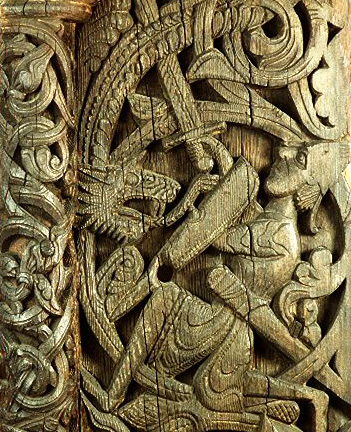Tolkien's The New Lay of the Völsungs and The New Lay of Gudrún: Overview and Thematic Exploration
"To hit you in the eyes was the deliberate intention of the Norse poet."
--from the Introduction
"But the land of Merlin and Arthur was better than these [adventure stories], and best of all the nameless North of Sigurd of the Völsungs, and the prince of all dragons."
--On Fairy-stories
"I find ‘dragons’ a fascinating product of imagination. But I don’t think the Beowulf one is frightfully good. But the whole problem of the intrusion of the ‘dragon’ into northern imagination and its transformation there is one I do not know enough about. Fafnir in the late Norse versions of the Sigurd-story is better; and Smaug and his conversation obviously is in debt there."
--Letter to Naomi Mitchison, 18 December 1949

Outline of Tolkien's Introduction to The Elder Edda
- Appreciation of the Poetry
- Philological Debt
- Old English versus Old Norse--The latter's sudden power and compression
- The Scandinavian Past
- Stone Age and Early Nordic cultures
- The Heroic Age (post-700AD)
- The Saga--the prose works
- The Poetic: Meter and Myth
- Transition Period Between Pagan and Christian
- Post-1100AD--Skaldic Poetry--The Prose Edda
- 16th/17th Century Revival of Interest
- 18th Century Dismissal of the Gothic
- The Codex Regius
Key Versions of the Myth that Influenced Tolkien
"The Story of Sigurd (adapted by Andrew Lang himself from Morris' translation of The Volsunga Saga) was my favorite without rival. Even as it stands in the Red Book that is no light matter; it is strong meat for nurseries."--Manuscript B of On Fairy-stories
- The Poetic Edda (850-1050AD)
- The Prose Edda (Snorri Strulson, ca. 1220AD)
- The Saga of the Volsungs (Volsungasaga; ca. 13th century)
- The Nibelungenlied (Germanic; ca. 1190-1200)
- The Story of Sigurd the Volsung and the Fall of the Niblungs (William Morris, 1876)
- "The Legend of Sigurd" (Andrew Lang, Red Fairy Book, 1890)
Other Minor Related Poems
- Waldere I and II--two Old English fragments of the story of Walter and Hildegyth who steal treasure from the court of Atli.
- Widsith--Old English poem from 9th century that lists some of the key peoples
- The Lament of Deor--Old English 10th century
The Poetic Form
Fornyrðislag 8-line (Old story meter): 2 half-lines with 2 stressed syllables each; the first half-line has 1 or 2 alliterating syllables; the second half-line should have one syllables that alliterates with the first half-line. 5 possible types of half-lines: (a) /x/x; (b) x/xx; (c) x//x; (d) //\x or //x\; (e) /\x/.
A Few Key Themes and Motifs
- Oathbreaking (eiðrofa)
- The Dragon
- Werewolves
- Heroic Culture
The Valkyrie Traditions
Leslie A. Donovan in her article "The Valkyrie Reflex in The Lord of the Rings" mentions the following characteristics associated with valkyrie traditions. They:- "Exhibit an otherworldly radiance, sometimes associated with the glittering shine of armor or with the fractured illumination linked to battle fires;"
- "Possess physical prowess equaling or exceeding that of male heroes;"
- "Serve ceremonial functions within the hall such as ritual cup-bearing at official occasions, gift-giving to heroes, and sewing or preserving special heroic garments, which challenge heroes to fulfill their destinies;"
- "Perform prophetic acts or engage in other speech acts that determine some future fate;"
- "Choose actions based on the operation of their own strong wills;"
- "Undergo the loss of something central and precious to their lives."
Discussion Questions
- In what ways does Tolkien take advantage of the compression and "pithy" nature of the Nordic verse pattern? Is it always effective?
- Are the early accounts of demons and dwarves essential to the tales? How so?
- Why do you think that the story of Sigurd and the dragon had such a strong impact on Tolkien as a child?
- Why are various kinds of oaths made and broken so important to the Lays of the Völsungs and Gudrún?
- How important is the magic and shape-shifting in the text?
- How should we respond to the (a)moral character of the Völsungs, the Niflungs, and the Huns?
- What role do the aspirations and plight of women play in the lays?
- How many of the characteristics of valkyrie does Brynhild?
